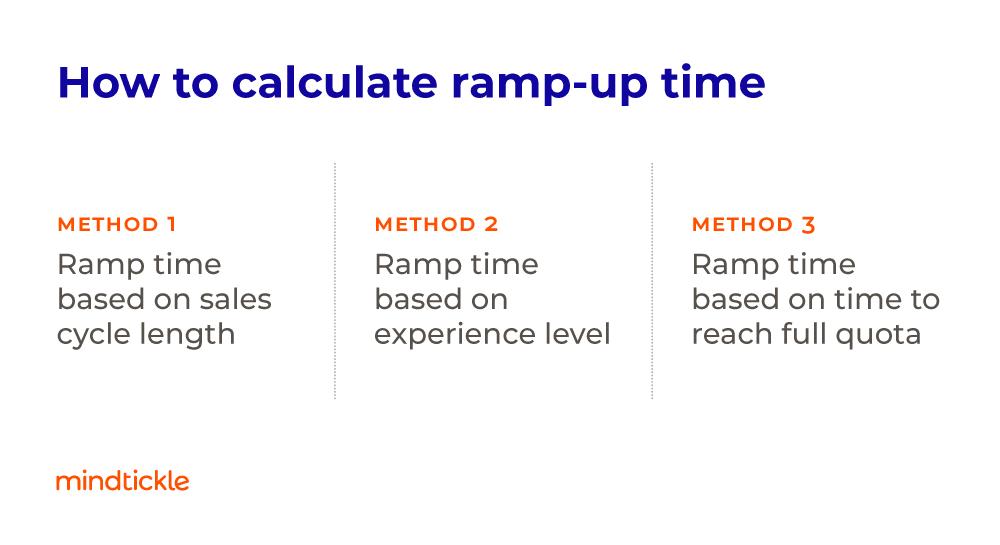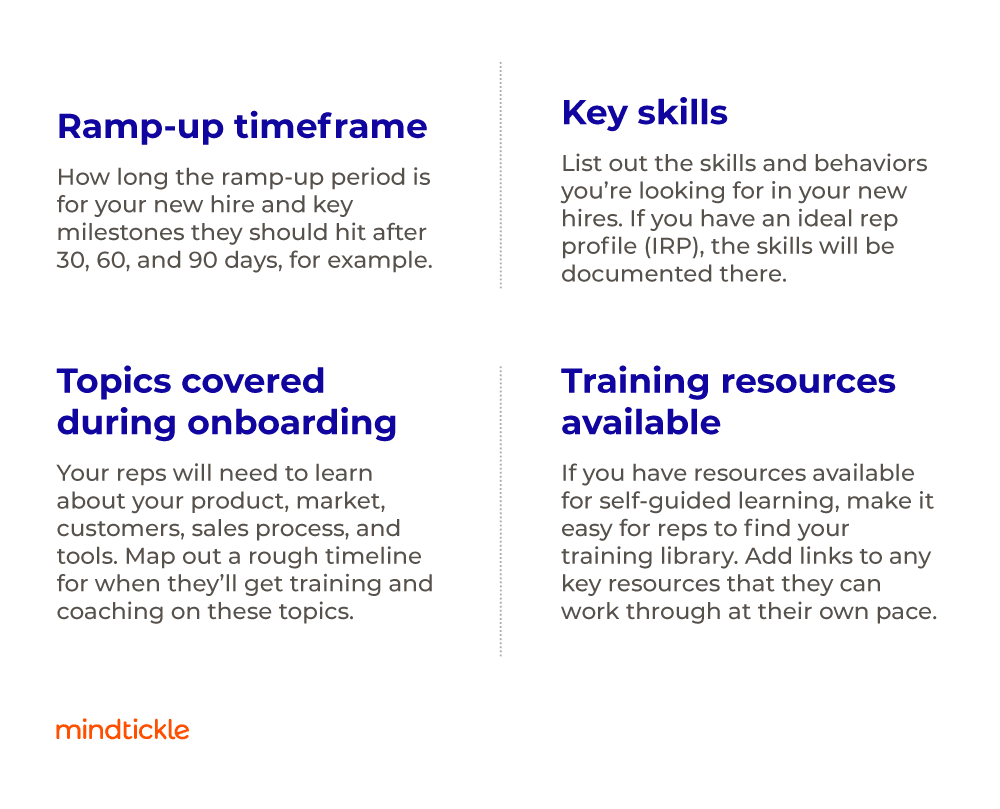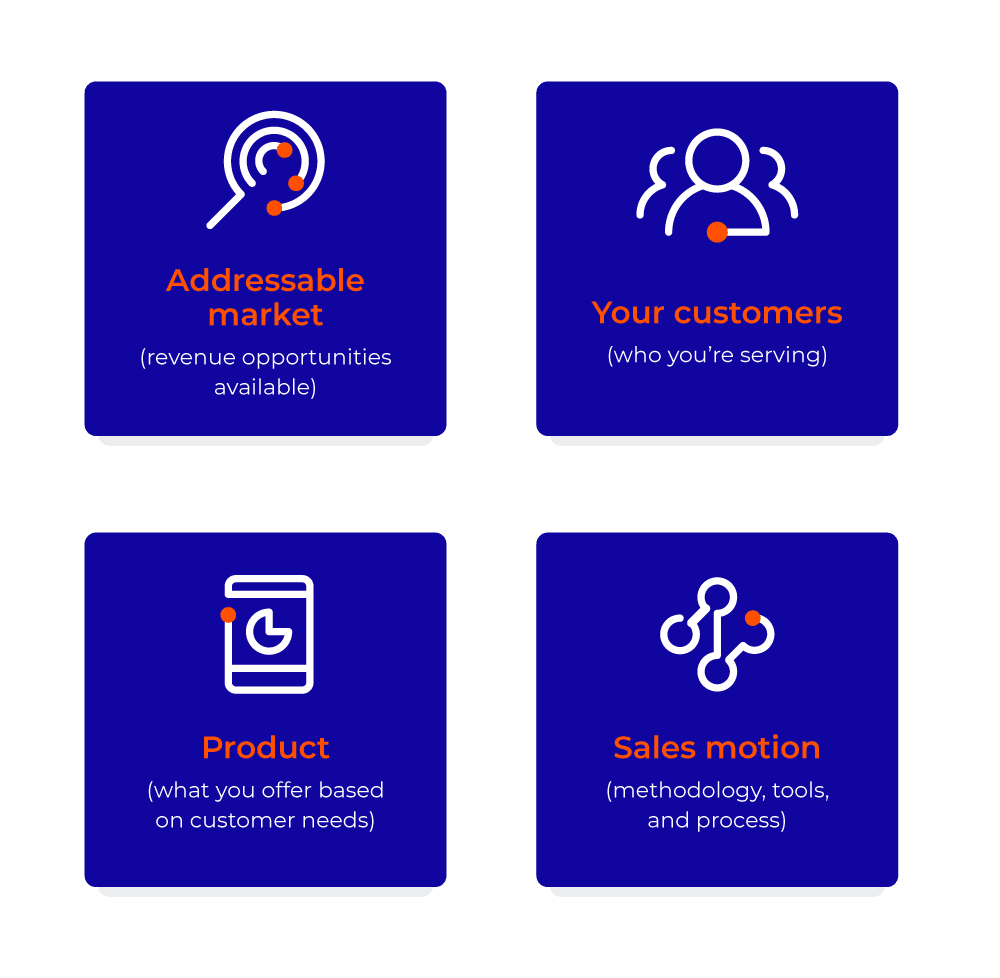Getting new hires up to speed is a major investment in both time and money for businesses. You pay their salary from day one, but it can take a long time for new sellers to hit quota and start bringing in revenue for the business. According to The Bridge Group, the average ramp-up time for sales development reps (SDRs) is 3.1 months. For account executives (AEs), it’s even longer—4.9 months.
Companies need to understand ramp-up time, what affects it, and how to calculate it to support new sales hires and help them reach full productivity sooner.
What is sales ramp-up time?
Ramp-up time is the amount of time it takes for new sales hires to reach full productivity after they join your company. It includes their onboarding period with time to complete product training, learn about your sales process, master your sales tools, and have initial coaching from managers or other colleagues.
Sales leaders need to know how long it takes to ramp up new hires, so they can create more accurate forecasts based on rep capacity. Additionally, it helps you plan your future hiring needs, so you can bring on new hires before your team is over capacity.
How to calculate ramp-up time for sales reps
Ramp-up time can be calculated in several ways. The right one for your organization depends on factors like average sales cycle length, product complexity, team size and structure, and the amount and type of training available to new hires. Here are three common ways companies calculate sales ramp-up time for new hires.


Method 1: Ramp-up time based on sales cycle length
The simplest way to calculate ramp-up time is to use the length of your sales cycle as a starting point. For example, if your average sales cycle takes three months from outreach to close, it should take a similar length of time for reps to reach full productivity. Some companies add an extra buffer—for example, if they have a short sales cycle, they might add an extra 90 days for reps to get up to speed.
This method is a great choice for fast-growing sales teams that hire in cohorts. It standardizes the ramp-up time for new hires, so it’s easy to see who’s on track and who needs some extra support to get to where they need to be. However, it’s not so good for enterprise companies with long sales cycles because they can’t afford to wait that long for reps to start bringing in new revenue. In that case, one of the methods below will be a better fit for your company.
Method 2: Ramp-up time based on experience level
Calculating ramp-up time based on a salesperson’s experience level is more complicated because it will vary for each rep. As before, you’ll use your average sales cycle length as a starting point, but depending on the experience level of your new hire, you’ll either add on or take off time.
For example, a brand-new college graduate may need a few extra weeks to complete training programs and build their knowledge from the ground up before they reach full productivity. However, if you’ve poached a top performer from one of your competitors, they’ll need less time than average because they’ll have a good level of industry and product knowledge from their past experience.
This calculation method is a good choice for teams that hire reps with very different skills and experience levels. It enables you to personalize targets, expectations, and training based on your reps’ individual needs.
Method 3: Ramp-up time based on time to reach full quota
Alternatively, you can calculate ramp-up time based on the average length of time it takes your new sales hires to reach full quota attainment. Here, the idea is to focus on sales productivity to benchmark new hire performance rather than your sales cycle. It’s a good choice if your company doesn’t have a standard sales cycle length — for example, if you sell products for different markets with very different sales processes.
This method helps you monitor rep progress and set targets by comparing their performance against your previous hires, using past hires as the blueprint for a successful onboarding period.
5 tips to reduce new hire ramp-up time
As we’ve seen, it can take months for your new sales hires to build the skills, knowledge, and confidence they need to be ready for high-value sales interactions. So here are some tips for getting your sales reps ramped up quickly and enabling them to start hitting their revenue targets sooner.
1. Create and share a ramp-up plan with new hires
Put together a document that outlines your ramp-up plan for new hires. If you have a standardized process, you can use templates for this, but if you calculate ramp-up time based on experience, you’ll need to personalize this for each rep. This document should include:


Sharing a copy of this plan with your new hires will help reps check that they’re on track and meeting your expectations every step of the way. Having visibility into your expectations and the ability to monitor their progress will enable reps to take greater ownership over their ramp-up time.
2. Plan your sales onboarding
A successful ramp-up period gives reps a complete understanding of your business and how it operates and sets them up for long-term success. Sales onboarding is the initial part of a longer ramp-up period for new hires.
It’s important to ensure your onboarding program maps the skills, processes, and content that will help your reps achieve success at your company — in both the short and long term.
Make sure you’re focusing on the areas that are most important to your business, such as:


Sales onboarding should also include revenue targets and quotas — the things your reps will be measured by when they’re fully on board. Take the time to set measurable goals so that your new hires have a clear understanding of your expectations from day one. Doing so will also help provide context as your reps move through the onboarding process.
3. Provide effective sales training and coaching
When they join a company, new sales hires often go through initial training to learn about product, market, sales process, and ideal customer profile. According to Training Industry, “Highly effective sales training reduces ramp-up time by up to seven weeks.” Successful training should be tailored to the needs of each rep and include personalized coaching and plenty of resources for self-guided learning.
By adopting an on-demand learning approach, you give reps the opportunity to learn at their own pace rather than waiting around for calls to shadow or for a supervisor to walk them through a particular selling approach. Having on-demand resources available for your reps to review and use for virtual role-plays will help your sellers get up to speed faster. It will also give them more confidence in their skills as they can be honed and evaluated in a virtual environment.
Some examples of common on-demand training modules include:
- Industry news and trends: Help reps start speaking your prospects’ language from the get-go by familiarizing them with how to talk about hot topics in your space and navigate industry jargon.
- Objection handling: Compile the most common objections that reps at your company face and provide strategies for overcoming them.
- Pitch presentations: Give your new reps the opportunity to learn and understand how you present your product to buyers.
- Veteran tips: Have your most seasoned sales reps provide their top tips for excelling in the field. It’s always great to hear advice from a high-performing peer!
- Sales process: Provide an overview of what the sales process at your organization looks like, including what reps are expected to do at each stage.
- Competitive insights: Ensure your reps have a strong understanding of how your product offering differs from that of your competitors and what makes yours stand out.
The best part about making these specific training modules available on demand is that it doesn’t take time away from your high-performing reps who are already busy selling, and it also ensures consistency in the onboarding process.
4. Monitor and review progress
As your reps move through the onboarding process, it can be difficult to gauge their comprehension levels and how close they are to being ready to start having real sales interactions. What helps is being able to track onboarding session completion rates, as well as conducting knowledge tests along the way. This will allow you to identify knowledge gaps and give more training attention where it’s needed.
Some key areas you’ll want to test for include:
- Product knowledge — especially the ability to effectively demo your product
- Competitive intel
- Pricing packages
- Buyer personas
- Post-sale services and support
- Prospecting processes
- How and when to qualify a lead
- Vertical- or territory-specific knowledge
- Ability to use your CRM
Using data is really the only concrete way to determine how prepared your reps are to sell. A Readiness Index is a great way to get a holistic view of reps’ sales readiness, factoring in coaching, knowledge, and skill. Managers should use this index — or other performance metrics — to monitor new hires’ progress and adapt their training and coaching to set them up for success.
5. Provide training beyond your onboarding program
Research by Gartner found that sellers forget “70% of the information they learn within a week of training, and 87% will forget it within a month.” Because of this, you need to create a culture of ongoing learning and continuous improvement to help reps develop and maintain the skills and knowledge they need to be effective when interacting with prospects.
Many companies provide their sellers with initial training during their onboarding period, but any additional training is limited to the annual sales kick-off.
But on-the-job learning shouldn’t stop with onboarding. Messaging, techniques, product offerings, and strategy are constantly evolving, so it’s integral to ensure ongoing sales readiness with continuous learning programs.
There are a number of different ways you can promote ongoing learning within your sales organization, such as:
- Microlearning modules: Great for quick tips and competitive intel
- Certification programs: Ideal for new product and messaging rollouts
- Quizzes: Perfect for gauging knowledge retention, so sales leaders know when to coach
- On-the-go learning: Provide mobile access to your training modules with an app or mobile dedicated site, so they can be accessed any time, anywhere
By taking an everboarding approach to sales training, you create a team culture of ongoing learning and allow new hires to practice their skills in a low-pressure environment. Everboarding also encourages spaced reinforcement of new topics at regular intervals to help reps retain the information they learned in their training. This will help new hires build their knowledge and skills more quickly to ramp up faster.
Support sales reps long term, not just in onboarding
Ramp-up times are a useful benchmark for monitoring the early progress of your new sales hires. But you want to set reps up for long-term success at your company — beyond their initial onboarding period. Building a culture of continuous learning, training, and practice (that extends beyond onboarding) will set your reps up for ongoing success.
If you’re ready to make the shift from onboarding to sales everboarding and extend your training and coaching beyond the ramp-up period, download our free checklist: 5 Must-Haves for Any Sales Everboarding Strategy









